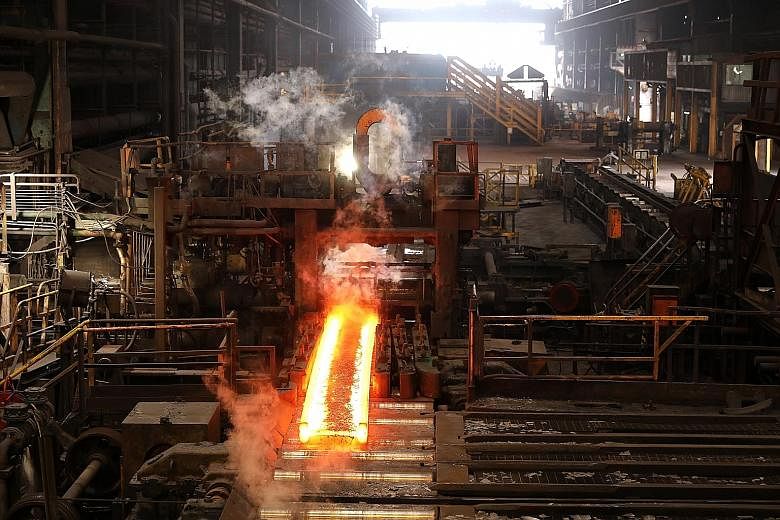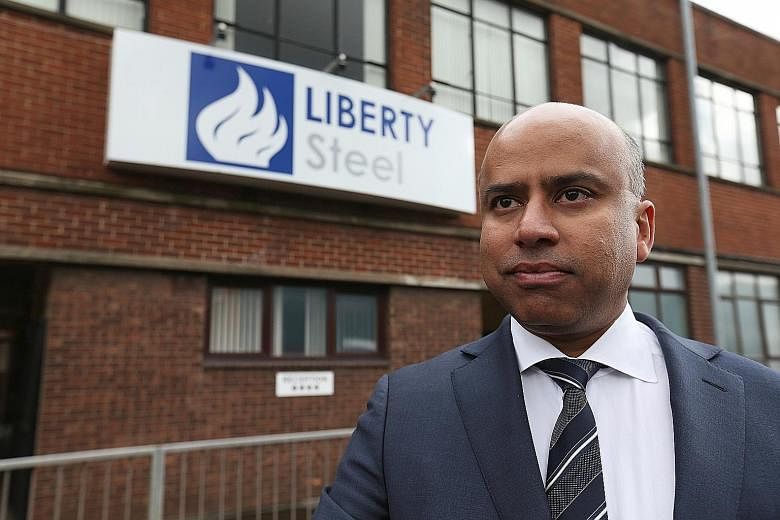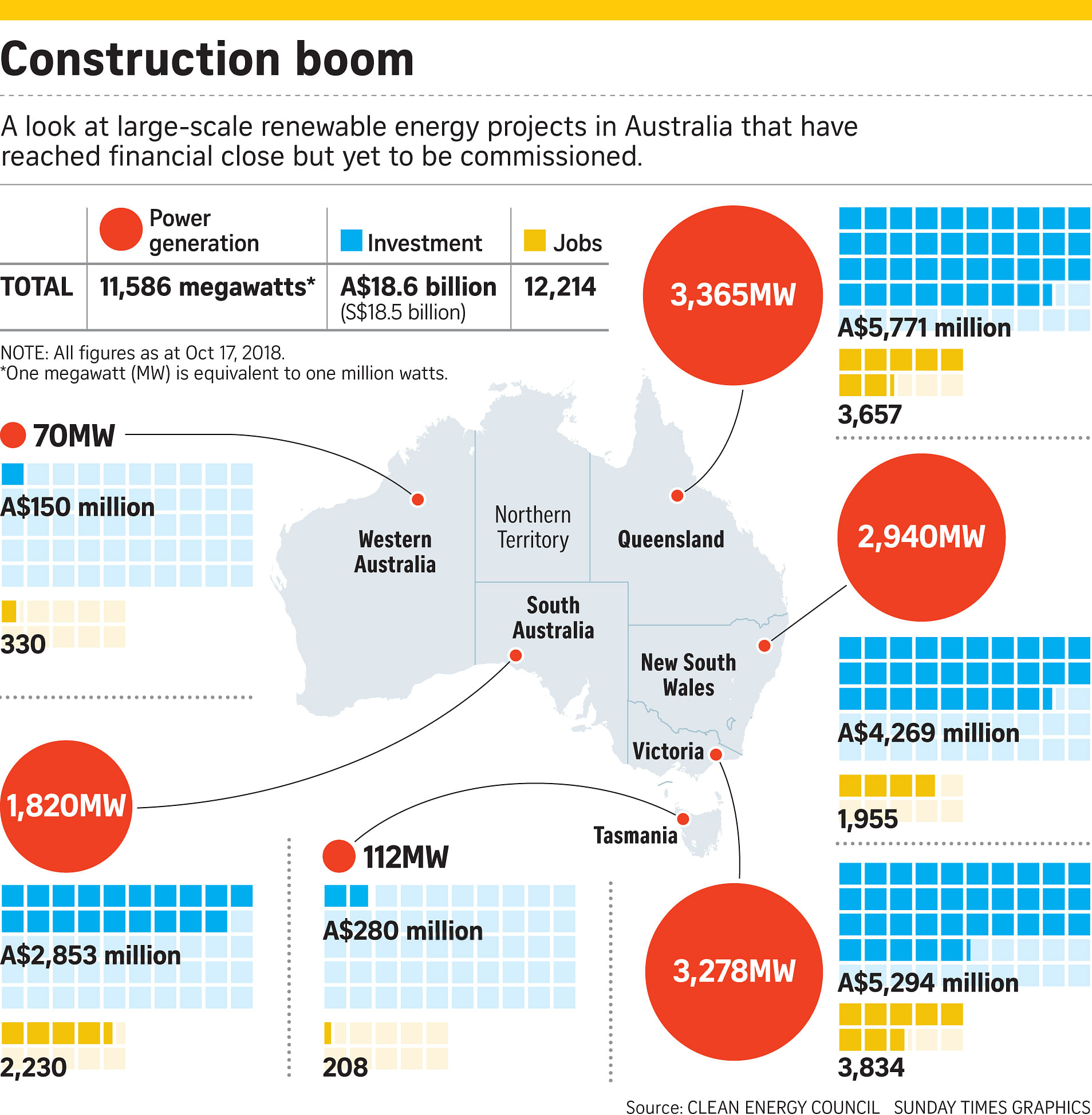Inside a dark steel mill in southern Australia, Mr Richard Cass watches with pride as the door of a blast furnace slowly grinds open and spits out a fresh slab of flaming steel.
Slowly, the steel rolls back and forth, cooling and elongating into a long plate that will be cut and sent around the world to help construct skyscrapers, railways and other infrastructure.
Mr Cass, 53, has worked for some 38 years at this steelworks, in the small town of Whyalla in South Australia. The plant is the lifeblood of the town: Mr Cass' father emigrated from Leeds to work there, and his brother and his niece are both also employees.
But the massive, Dickensian-looking plant has undergone a dramatic transformation in recent years. In 2016, it was set to shut after its heavily indebted owner went into voluntary administration amid falling global commodity prices and demand.
At the last moment, with the future of the plant and the town in doubt, it was bought by Indian-born British billionaire Sanjeev Gupta - the so-called "Man of Steel".
But Mr Gupta, the head of London-based global industrial group GFG Alliance, is adopting a radical new approach: He is pursuing a new "green steel" vision for the steelworks, which involves using recycled metals and powering the plant with renewable energy.
In this Australian state, which has become a world leader in producing renewable energy, the turnaround of the Whyalla steelworks is emblematic of a concerted push to shift from a coal-fired industrial past to a clean energy future.
Like many in Whyalla, Mr Cass described Mr Gupta as a "saviour".
"Without the steelworks, this town would not exist," he told The Sunday Times.
A A$170 million (S$169 million) plan to convert a disused mine pit into a pumped hydro energy facility is part of Mr Gupta's A$1 billion-plus plans that include construction of a vast renewable plant and the world's largest lithium-ion battery, as well as a new steel plant. The renewable plant will power the steelworks and sell the remaining power to the state's energy grid or other large users.
Describing his vision to The Sunday Times, Mr Gupta said: "The model is: We will solve our own problems by reducing energy prices, but we will also supply power to other users to take advantage of the disruption we have taken (to local power production)."
WHAT MAKES WHYALLA APPEALING
Mr Gupta, a Cambridge-educated industrialist who was born into a family of Indian steel-mill owners, has interests spanning more than 30 countries but described Whyalla as "my spiritual home". He said South Australia - with its abundant sunlight and high energy prices - was ideally suited for large-scale investment in renewables.
In addition, he said, powering the steelworks with its own energy source will help to avoid the risks from a power blackout. Famously, South Australia suffered a state-wide blackout in 2016: If it had lasted another six hours, slurry could have solidified and damaged pipelines, effectively crippling the plant.
"Some of the best conditions on the planet (for renewable energy) exist in Australia, and in South Australia in particular," Mr Gupta said. "We have the best radiation to make maximum power per panel, and the panel prices have come down, and energy prices are high. It is the perfect storm to make investment in renewables."
In a patch of brushy landscape alongside the steelworks, the extent of Mr Gupta's vision becomes clear. On this 1,100ha site, Mr Gupta's majority-owned renewables company, Simec Zen Energy (SZE), plans to build a 280MW solar plant, including 780,000 panels worth about A$300 million. The plant will produce enough power for over 96,000 homes. Construction is due to begin early next year and the plant is due to be completed by 2021.
SZE project manager Sturt Daley said the plant should recoup its costs in about seven years. He said the project is part of South Australia's renewable revolution and believes the state is setting a path towards a clean energy future that other states and nations will follow.
"There is every chance Australia will be able to run off renewables with people like Sanjeev to get some really strong sites in the ground," he told The Sunday Times.
Mr Daley noted that South Australia has - on four separate occasions in recent years - been powered entirely by renewable energy.
"That is proof that you can run large infrastructure with renewables," he said. "Renewable energy is going to become the norm."
SIGNS OF THE TIMES
Indeed, the signs of the state's embrace of renewables are everywhere. Down the road from the steelworks, thousands of solar panels gleam from a 6MW plant, developed by Chinese firm SSE, which sells the power to the grid.
"Whyalla is commonly known as the 'steel city'... but it is fast moving towards becoming the 'solar capital' because of its idyllic solar farming conditions," says the project's website.
South Australia currently has plans for almost 30 large-scale solar, wind and battery storage projects that will add more than 6,000MW to the grid. Last year, 43 per cent of the state's power came from renewables, compared with 15 per cent for the entire nation, according to federal government data.
But the rest of the nation is following South Australia's lead and quickly embracing renewables. In September, Australia's solar energy capacity reached a record 10.1GW of capacity, a four-fold increase in just five years, according to the Australian Photovoltaic Institute. Across Australia, there are 73 large-scale renewable projects worth A$18.6 billion that are planned or under way, according to the Clean Energy Council. These are expected to deliver a capacity of about 11.6GW and over 12,000 jobs.
Despite the ruling coalition in August rejecting a proposed target for emissions cuts by the energy sector, firms and investors have been rushing to develop solar and wind projects which not only deliver clean electricity, but can also be relatively cheap and fast to develop.
Curiously, one of the epicentres of the renewable transformation is Port Augusta, a town about an hour's drive north of Whyalla which was once home to the state's last coal-fired power station. The 60-year-old Alinta Energy station closed in 2016, due to weak prices and the growth of the renewables sector.
Now, all that remains of the plant is a lone, unused chimney - a sort of blackened monument to the state's coal-dependent past. Port Augusta is fast shifting to a green future and has been described by its mayor Sam Johnson as "the renewables capital of Australia".
The town is due to house the 300MW Bungala solar farm, which will open next year and generate enough power for about 82,000 households.
Another dozen solar and wind projects are planned for the area. This includes a planned A$650 million solar thermal project developed by United States-based firm Solar Reserve - the largest such project in the world.
It will include a 250m tower, surrounded by 10,000 heliostats, or movable mirrors, that will track the sun and concentrate sunlight, heating molten salt in a process that will allow for storage of 1,100 megawatt-hours of electricity.
These renewable projects are helping to create a new and hopeful future for regional areas across South Australia. They have delivered local investment and are set to create thousands of construction jobs as well as hundreds of long-term employment opportunities.
Whyalla's deputy mayor Clare McLaughlin said Mr Gupta's purchase of the steelworks and his renewables-based plan for the town had generated interest from other investors and were "critical to our revival". "It had a very tough effect on the town when the plant went into the administration," she told The Sunday Times. "Mr Gupta investing in the plant put a lot of positive energy into our city."
Whyalla City Council's chief executive Chris Cowley said the town was looking for other solar opportunities, such as for horticulture businesses that could build plants to power their operations and also sell power to the grid. The town, he said, has "consistent bankable solar energy". "Whyalla has 300 days of uninterrupted sunshine," he said. "It is one of the prime areas in Australia to invest in solar."
Mr Gupta, a regular visitor to the town, has become something of a local celebrity. He said he has had no problem adjusting to the small town of 23,000 people, which is almost 400km from Adelaide, the state capital. "Culturally it was not much of a shock," he said. "Steel people are steel people... This is a one-company town, so the commitment the people and the town have to the business is profound. The fact that it had a near death experience made them closer to the business."
Back in the mill, Mr Cass said he believed the plan for an upgraded, clean energy steelworks would ensure the plant and the town had a "long, long future". "It is not just about me," he said. "It is my family, it is the community, it is the town."



